 Tìm kiếm
Tìm kiếm
Chương II Thông tư 18/2023/TT-BTC thu nộp tiền phạt bừ trừ số tiền nộp phạt vi phạm hành chính chênh lệch: Thủ tục thu, nộp tiền phạt và tiền chậm nộp vi phạm hành chính, bù trừ số tiền nộp phạt chênh lệch
| Số hiệu: | 18/2023/TT-BTC | Loại văn bản: | Thông tư |
| Nơi ban hành: | Bộ Tài chính | Người ký: | Võ Thành Hưng |
| Ngày ban hành: | 21/03/2023 | Ngày hiệu lực: | 05/05/2023 |
| Ngày công báo: | 10/05/2023 | Số công báo: | Từ số 693 đến số 694 |
| Lĩnh vực: | Thuế - Phí - Lệ Phí, Vi phạm hành chính, Tài chính nhà nước | Tình trạng: | Còn hiệu lực |
TÓM TẮT VĂN BẢN
Bổ sung trường hợp không tính chậm nộp phạt vi phạm hành chính
Ngày 21/3/2023, Bộ trưởng Bộ Tài chính ban hành Thông tư 18/2023/TT-BTC quy định thủ tục thu, nộp tiền phạt, bù trừ số tiền nộp phạt, biên lai thu tiền phạt và kinh phí từ NSNN bảo đảm hoạt động của lực lượng xử phạt VPHC.
Theo đó, không tính tiền chậm nộp phạt VPHC trong các trường hợp:
- Trong thời hạn được hoãn thi hành quyết định xử phạt vi phạm hành chính;
- Trong thời gian xem xét, quyết định giảm, miễn phần còn lại hoặc cho phép nộp tiền phạt nhiều lần. (quy định mới).
Bên cạnh đó, Thông tư cũng hướng dẫn xác định ngày người nộp tiền phạt đã thực hiện nghĩa vụ nộp tiền phạt như sau:
- Trường hợp nộp tiền phạt bằng tiền mặt trực tiếp: là ngày Kho bạc Nhà nước hoặc ngân hàng thương mại nơi KBNN mở tài khoản hoặc tổ chức cung ứng dịch vụ bưu chính công ích hoặc người có thẩm quyền thu tiền phạt xác nhận trên chứng từ thu, nộp tiền phạt;
- Trường hợp nộp tiền phạt bằng hình thức chuyển khoản: là ngày người nộp tiền phạt nhận được thông báo giao dịch tiếp nhận khoản tiền nộp phạt thành công.
Xem chi tiết tại Thông tư 18/2023/TT-BTC có hiệu lực từ ngày 05/5/2023, thay thế Thông tư 153/2013/TT-BTC và Thông tư 105/2014/TT-BTC .
Văn bản tiếng việt
Hình thức thu, nộp tiền phạt vi phạm hành chính được thực hiện theo quy định tại khoản 1 Điều 20 Nghị định số 118/2021/NĐ-CP ngày 23 tháng 12 năm 2021 của Chính phủ quy định chi tiết một số điều và biện pháp thi hành Luật Xử lý vi phạm hành chính (sau đây gọi là Nghị định số 118/2021/NĐ-CP). Thông tư này hướng dẫn cụ thể một số nội dung như sau:
1. Trường hợp nộp tiền phạt bằng tiền mặt trực tiếp, ngày xác định người nộp tiền phạt đã thực hiện nghĩa vụ nộp tiền phạt là ngày Kho bạc Nhà nước hoặc ngân hàng thương mại nơi Kho bạc Nhà nước mở tài khoản hoặc tổ chức cung ứng dịch vụ bưu chính công ích hoặc người có thẩm quyền thu tiền phạt theo quy định tại điểm c khoản 1 Điều 20 Nghị định số 118/2021/NĐ-CP xác nhận trên chứng từ thu, nộp tiền phạt.
2. Trường hợp nộp tiền phạt bằng hình thức chuyển khoản, ngày xác định người nộp tiền phạt đã thực hiện nghĩa vụ nộp tiền phạt là ngày người nộp tiền phạt nhận được thông báo giao dịch tiếp nhận khoản tiền nộp phạt thành công từ ngân hàng thương mại, tổ chức cung ứng dịch vụ trung gian thanh toán, tổ chức cung ứng dịch vụ bưu chính công ích để nộp vào ngân sách nhà nước.
Quy trình, thủ tục thu, nộp tiền phạt vi phạm hành chính được thực hiện theo quy trình thu ngân sách nhà nước quy định tại Nghị định số 11/2020/NĐ-CP ngày 20 tháng 01 năm 2020 của Chính phủ quy định về thủ tục hành chính thuộc lĩnh vực Kho bạc Nhà nước (sau đây gọi là Nghị định số 11/2020/NĐ-CP) và Thông tư số 328/2016/TT-BTC. Thông tư này hướng dẫn cụ thể các nội dung sau:
1. Việc thu tiền phạt vi phạm hành chính phải căn cứ vào quyết định xử phạt vi phạm hành chính của người có thẩm quyền xử phạt theo quy định tại Luật Xử lý vi phạm hành chính và các Nghị định của Chính phủ quy định về xử phạt vi phạm hành chính trong từng lĩnh vực.
2. Khi nộp tiền phạt trực tiếp tại Kho bạc Nhà nước hoặc ngân hàng thương mại nơi Kho bạc Nhà nước mở tài khoản hoặc tổ chức cung ứng dịch vụ bưu chính công ích thì cá nhân, tổ chức bị xử phạt phải xuất trình quyết định xử phạt của người có thẩm quyền xử phạt với Kho bạc Nhà nước nơi đến nộp phạt hoặc ngân hàng thương mại nơi Kho bạc Nhà nước mở tài khoản hoặc tổ chức cung ứng dịch vụ bưu chính công ích và phải nộp tiền phạt theo đúng số tiền, thời hạn ghi trong quyết định xử phạt.
Trường hợp nộp tiền phạt bằng hình thức chuyển khoản thì cá nhân, tổ chức bị xử phạt phải căn cứ vào quyết định xử phạt để nộp tiền phạt theo đúng số tiền, thời hạn ghi trong quyết định xử phạt. Thông tin chuyển khoản phải bao gồm nội dung nộp phạt vi phạm hành chính, số quyết định xử phạt, ngày ra quyết định xử phạt, tên cơ quan của người có thẩm quyền ra quyết định xử phạt.
3. Người có thẩm quyền thu tiền phạt trực tiếp quy định tại điểm c khoản 1 Điều 20 Nghị định số 118/2021/NĐ-CP phải lập Bảng kê thu tiền phạt theo Mẫu số 02/BKTP ban hành kèm theo Thông tư số 328/2016/TT-BTC và nộp toàn bộ số tiền đã thu vào Kho bạc Nhà nước theo thời gian quy định tại khoản 2 Điều 69, khoản 1 Điều 78 Luật Xử lý vi phạm hành chính. Cảng vụ hoặc đại diện cảng vụ hàng không khi thực hiện thu tiền phạt theo điểm c khoản 1 Điều 20 Nghị định số 118/2021/NĐ-CP phải nộp toàn bộ số tiền đã thu vào Kho bạc Nhà nước trong thời hạn 2 ngày làm việc, kể từ ngày thu tiền phạt.
Kho bạc Nhà nước rà soát, đối chiếu để đảm bảo khớp đúng giữa tổng số tiền thực nộp của người có thẩm quyền thu tiền phạt trực tiếp với tổng số tiền tính theo Bảng kê thu tiền phạt.
4. Khi nộp tiền phạt theo quy định tại điểm c Khoản 2 Điều 20 Nghị định số 118/2021/NĐ-CP, chứng từ thu, nộp tiền phạt phải thể hiện rõ nội dung nộp phạt vi phạm hành chính, số quyết định xử phạt, ngày ra quyết định xử phạt, tên cơ quan của người có thẩm quyền ra quyết định xử phạt. Sau khi nộp phạt, cá nhân, tổ chức bị xử phạt xuất trình hoặc gửi chứng từ thu, nộp tiền phạt cho người có thẩm quyền xử phạt để nhận lại các giấy tờ tạm giữ theo quy định tại điểm c Khoản 2 Điều 20 Nghị định số 118/2021/NĐ-CP.
5. Tiền thu phạt vi phạm hành chính được hạch toán vào Chương của cơ quan của người có thẩm quyền ra quyết định xử phạt, Tiểu mục tương ứng theo quy định của Mục lục ngân sách nhà nước. Đối với lĩnh vực thuế, hải quan thực hiện theo Chương của người vi phạm (người nộp thuế), Tiểu mục tương ứng theo quy định của Mục lục ngân sách nhà nước.
1. Quá thời hạn thi hành quyết định xử phạt vi phạm hành chính quy định tại khoản 2 Điều 68 và khoản 1 Điều 73 Luật Xử lý vi phạm hành chính mà cá nhân, tổ chức chưa nộp tiền phạt thì sẽ bị cưỡng chế thi hành quyết định xử phạt và cứ mỗi ngày chậm nộp phạt, cá nhân, tổ chức vi phạm phải nộp thêm 0,05% trên tổng số tiền phạt chưa nộp.
Số ngày chậm nộp tiền phạt bao gồm cả ngày lễ, ngày nghỉ theo chế độ quy định và được tính từ ngày tiếp sau ngày cuối cùng của thời hạn nộp tiền phạt đến trước ngày cá nhân, tổ chức vi phạm hành chính nộp tiền phạt vào ngân sách nhà nước.
2. Không tính tiền chậm nộp phạt vi phạm hành chính trong các trường hợp sau:
a) Trong thời hạn được hoãn thi hành quyết định xử phạt vi phạm hành chính;
b) Trong thời gian xem xét, quyết định giảm, miễn phần còn lại hoặc cho phép nộp tiền phạt nhiều lần.
3. Cơ quan thu tiền phạt quy định tại khoản 1 Điều 3 Thông tư này căn cứ vào quyết định xử phạt, số ngày chậm nộp phạt để tính và thu tiền chậm nộp phạt khi cá nhân, tổ chức nộp tiền phạt vi phạm hành chính.
Trường hợp cá nhân, tổ chức nộp tiền phạt bằng hình thức chuyển khoản quy định tại khoản 2 Điều 3 Thông tư này phải căn cứ vào quyết định xử phạt, số ngày chậm nộp phạt để tính và nộp tiền chậm nộp phạt.
4. Cách xác định thời gian để tính tiền chậm nộp phạt như sau:
a) Trường hợp quyết định xử phạt được giao trực tiếp thì ngày tính tiền chậm nộp phạt là sau 10 ngày (bao gồm cả ngày lễ, ngày nghỉ) hoặc sau thời hạn thi hành ghi trong quyết định xử phạt vi phạm hành chính kể từ ngày nhận quyết định xử phạt theo quy định tại Luật Xử lý vi phạm hành chính;
b) Trường hợp quyết định xử phạt được gửi qua bưu điện bằng hình thức bảo đảm thì ngày tính tiền chậm nộp phạt là sau 10 ngày (bao gồm cả ngày lễ, ngày nghỉ) hoặc sau thời hạn thi hành ghi trong quyết định xử phạt vi phạm hành chính kể từ ngày quyết định xử phạt được phát hợp lệ theo quy định tại khoản 3 Điều 11 Luật Bưu chính ngày 17 tháng 6 năm 2010;
c) Trường hợp cá nhân, tổ chức bị xử phạt không có xác nhận ngày nhận quyết định xử phạt, không xuất trình được ngày quyết định xử phạt được phát hợp lệ theo quy định tại điểm a, điểm b khoản này, nhưng không thuộc trường hợp cố tình không nhận quyết định xử phạt theo quy định tại điểm d khoản này thì ngày tính tiền nộp chậm thi hành quyết định xử phạt tính từ ngày ra quyết định xử phạt là sau 12 ngày (bao gồm cả ngày lễ, ngày nghỉ) đối với trường hợp quyết định xử phạt ghi thời hạn là 10 ngày kể từ ngày ra quyết định xử phạt hoặc từ ngày thứ ba sau thời hạn thi hành ghi trong quyết định xử phạt đối với trường hợp quyết định xử phạt ghi thời hạn nhiều hơn 10 ngày kể từ ngày ra quyết định xử phạt (bao gồm cả ngày lễ, ngày nghỉ).
Trường hợp người nộp phạt chứng minh được ngày nhận quyết định xử phạt và việc chứng minh là có cơ sở thì cơ quan thu tiền phạt quy định tại khoản 1 Điều 3 Thông tư này tính tiền nộp chậm thi hành quyết định xử phạt sau 10 ngày hoặc sau thời hạn thi hành ghi trong quyết định xử phạt kể từ ngày nhận được quyết định xử phạt mà người nộp phạt đã chứng minh;
d) Đối với các trường hợp cố tình không nhận quyết định xử phạt thì thực hiện theo quy định tại Điều 70 Luật Xử lý vi phạm hành chính. Cơ quan của người có thẩm quyền ra quyết định xử phạt, cơ quan có thẩm quyền cưỡng chế thông báo cho Kho bạc Nhà nước nơi thu tiền phạt về thời điểm được coi là giao quyết định xử phạt để Kho bạc Nhà nước tính tiền chậm nộp phạt.
đ) Trường hợp cá nhân, tổ chức bị xử phạt cố tình không nộp tiền chậm nộp phạt, thì cơ quan có thẩm quyền thu tiền phạt quy định tại khoản 1 Điều 3 Thông tư này thu tiền nộp phạt vi phạm hành chính trên quyết định xử phạt; đồng thời, vẫn tính tiền chậm nộp phạt và ghi rõ trên chứng từ thu, nộp tiền phạt số tiền chậm nộp tính đến trước ngày cá nhân, tổ chức vi phạm hành chính nộp tiền.
5. Cơ quan có thẩm quyền thu phạt quy định tại khoản 1 Điều 3 Thông tư này sử dụng biên lai thu tiền phạt không in sẵn mệnh giá, biên lai thu tiền phạt lập và in từ Chương trình ứng dụng thu ngân sách nhà nước hoặc chứng từ khác theo quy định của pháp luật để thu tiền chậm nộp phạt.
6. Tiền chậm nộp phạt được nộp vào ngân sách nhà nước theo quy định tại khoản 5 Điều 4 Thông tư này.
7. Số tiền chậm nộp phạt thực hiện hạch toán theo mục lục ngân sách nhà nước.
1. Cách tính số tiền nộp phạt chênh lệch
Số tiền nộp phạt chênh lệch phát sinh trong trường hợp có quyết định đính chính, sửa đổi, bổ sung, hủy bỏ hoặc ban hành quyết định mới trong xử phạt vi phạm hành chính được tính như sau:
Số tiền nộp phạt chênh lệch = A - B
Trong đó:
- A là số tiền nộp phạt mà cá nhân, tổ chức vi phạm đã nộp vào ngân sách nhà nước theo quyết định xử phạt vi phạm hành chính của cấp có thẩm quyền.
- B là số tiền nộp phạt mà cá nhân, tổ chức vi phạm phải nộp theo quyết định đính chính, sửa đổi, bổ sung, hủy bỏ hoặc quyết định mới của cấp có thẩm quyền.
2. Xử lý số tiền nộp phạt chênh lệch
Trường hợp số tiền nộp phạt tại quyết định đính chính, sửa đổi, bổ sung, hủy bỏ hoặc quyết định mới lớn hơn số tiền nộp phạt mà cá nhân, tổ chức vi phạm đã nộp vào ngân sách nhà nước (B>A) thì cá nhân, tổ chức vi phạm nộp số tiền phạt còn thiếu theo thủ tục nộp tiền vào ngân sách nhà nước quy định tại Điều 4 Nghị định số 11/2020/NĐ-CP.
Trường hợp số tiền nộp phạt tại quyết định đính chính, sửa đổi, bổ sung, hủy bỏ hoặc quyết định mới nhỏ hơn số tiền nộp phạt mà cá nhân, tổ chức vi phạm đã nộp vào ngân sách nhà nước (B<A) thì cá nhân, tổ chức vi phạm được hoàn trả số tiền phạt nộp thừa. Nguồn hoàn trả và thủ tục hoàn trả được thực hiện theo quy định tại khoản 3 Điều 7 Thông tư này.
3. Việc bù trừ số tiền phạt nộp thừa với số tiền thuế, tiền chậm nộp hoặc tiền phạt người nộp thuế còn nợ trong lĩnh vực hải quan thực hiện theo quy định tại Điều 132 Thông tư số 38/2015/TT-BTC ngày 25 tháng 3 năm 2015 của Bộ trưởng Bộ Tài chính quy định về thủ tục hải quan; kiểm tra, giám sát hải quan; thuế xuất khẩu, thuế nhập khẩu và quản lý thuế đối với hàng hóa xuất khẩu, nhập khẩu được sửa đổi, bổ sung theo khoản 65 Điều 1 Thông tư số 39/2018/TT-BTC ngày 20 tháng 4 năm 2018 của Bộ trưởng Bộ Tài chính sửa đổi, bổ sung một số điều tại Thông tư số 38/2015/TT-BTC ngày 25 tháng 3 năm 2015 của Bộ trưởng Bộ Tài chính (sau đây gọi là Thông tư số 38/2015/TT-BTC).
Việc bù trừ số tiền phạt nộp thừa với số tiền thuế còn nợ, tiền chậm nộp còn nợ, tiền phạt còn nợ hoặc trừ vào số tiền thuế, tiền chậm nộp, tiền phạt phát sinh phải nộp của lần tiếp theo trong lĩnh vực thuế thực hiện theo quy định tại Thông tư số 80/2021/TT-BTC ngày 29 tháng 9 năm 2021 của Bộ trưởng Bộ Tài chính hướng dẫn thi hành một số điều của Luật Quản lý thuế và Nghị định số 126/2020/NĐ-CP ngày 19 tháng 10 năm 2020 của Chính phủ quy định chi tiết một số điều của Luật Quản lý thuế (sau đây gọi là Thông tư số 80/2021/TT-BTC).
1. Cá nhân, tổ chức bị xử lý vi phạm hành chính có quyền khiếu nại, khởi kiện đối với quyết định xử lý vi phạm hành chính theo quy định của pháp luật; Cá nhân có quyền tố cáo đối với hành vi vi phạm pháp luật trong việc xử lý vi phạm hành chính theo quy định của pháp luật.
2. Cá nhân, tổ chức tại khoản 1 Điều này được hoàn trả số tiền phạt thu không đúng trong thời hạn 15 ngày, kể từ ngày ra quyết định giải quyết khiếu nại hoặc từ ngày nhận được quyết định xử lý của cơ quan có thẩm quyền.
Quyết định xử lý của cơ quan có thẩm quyền bao gồm: Quyết định của cơ quan quản lý hành chính nhà nước có thẩm quyền hoặc bản án, quyết định có hiệu lực của Tòa án có thẩm quyền theo quy định của pháp luật.
3. Nguồn hoàn trả và thủ tục hoàn trả:
a) Nguồn hoàn trả tiền thu từ xử phạt vi phạm hành chính thực hiện theo quy định tại Điều 10 Thông tư số 328/2016/TT-BTC được sửa đổi, bổ sung tại khoản 9 Điều 1 Thông tư số 72/2021/TT-BTC; thủ tục hoàn trả thực hiện theo quy định tại Điều 5 Nghị định số 11/2020/NĐ-CP, Điều 10 Thông tư số 328/2016/TT-BTC được sửa đổi, bổ sung tại khoản 9 Điều 1 Thông tư số 72/2021/TT-BTC (trừ các trường hợp quy định tại điểm b khoản này);
b) Nguồn hoàn trả và thủ tục hoàn trả tiền thu từ xử phạt vi phạm hành chính về thuế thực hiện theo Thông tư số 80/2021/TT-BTC; trong lĩnh vực hải quan thực hiện theo Thông tư số 38/2015/TT-BTC.
PROCEDURES FOR COLLECTION AND PAYMENT OF FINES AND INTEREST ON LATE PAYMENT OF FINES; HANDLING OF DIFFERENCES BETWEEN FINES
Article 3. Collection and payment of fines
Forms of collection and payment of fines shall be as defined in clause 1 of Article 20 in the Government's Decree No. 118/2021/ND-CP dated December 23, 2021, elaborating on certain articles and measures for enforcement of the Law on Handling of Administrative Violations (hereinafter referred to as Decree No. 118/2021/ND-CP). This Circular provides detailed guidance on implementation of some of the following regulations:
1. If a fine is paid directly in cash, the date of confirmation of the fine payer’s completed payment of the fine is the day on which the State Treasury or a commercial bank where the State Treasury has its account opened; or a public postal service provider; or a person having jurisdiction to collect fines that is referred to in point c of clause 1 of Article 20 in the Decree No. 118/2021/ND-CP, certifies the receipt for that fine.
2. If a fine is paid by a wire transfer, the date of confirmation of the fine payer’s completed payment of the fine is the day on which the fine payer receives a notification of successful transfer of the fine from a commercial bank, a payment intermediary service provider or public postal service provider for payment into the state budget.
Article 4. Procedures and documentation requirements for collection and payment of fines
Procedures and documentation requirements for collection and payment of fines shall be the same as those for state budget collection specified in the Government’s Decree No. 11/2020/ND-CP dated January 20, 2020, prescribing state-treasury administrative procedures (hereinafter refer to as Decree No. 11/2020/ND-CP), and the Circular No. 328/2016/TT-BTC. This Circular provides the following detailed instructions:
1. Collection of a fine shall be based on an administrative penalty decision of a person having jurisdiction to impose penalties in accordance with the Law on Handling of Administrative Violations and Government's Decrees on administrative penalties in corresponding sectors.
2. When paying a fine directly at the State Treasury or a commercial bank where the State Treasury has its account opened or a public postal service provider, as a payer of that fine, the penalized entity or person is required to present an administrative penalty decision issued by a person having jurisdiction to impose penalties to the State Treasury where they come to pay the fine, or the commercial bank where the State Treasury has its account opened or a public postal service provider, and pay the given amount of fine within the time limit specified in the administrative penalty decision.
If a fine is paid by a wire transfer, the penalized entity or person is required to comply with the administrative penalty decision by paying the given amount of fine within the time limit specified in the administrative penalty decision. Information about the wire transfer of a fine should include the description of reasons for payment of the fine; the reference number of the administrative penalty decision; the date of issuance of the administrative penalty decision; the name of the employer of the person having jurisdiction to issue the administrative penalty decision.
3. The person having jurisdiction to collect the fine directly that is defined in point c of clause 1 of Article 20 in the Decree No. 118/2021/ND-CP shall have the duty to complete the Cash Declaration Form No. 02/BKTP enclosed in the Circular No. 328/2016/TT-BTC, and remit all the collected money to the State Treasury within the time limit specified in clause 2 of Article 69 and clause 1 of Article 78 in the Law on Handling of Administrative Violations. When collecting fines pursuant to point c of clause 1 of Article 20 in the Decree No. 118/2021/ND-CP, port authorities or representatives of port authorities are required to remit all the collected money to the State Treasury within 02 working days after the dates of collection of fines.
The State Treasury shall check and compare total amount remitted by the person having jurisdiction to collect fines directly with total amount calculated according to the completed Cash Declaration Form to ensure all data match.
4. When paying a fine according to point c of clause 2 of Article 20 in the Decree No. 118/2021/ND-CP, the documentary evidence of collection and payment of that fine should clearly describe reasons for payment of the fine; the reference number of the administrative penalty decision; the date of issuance of the administrative penalty decision; the name of the employer of the person having jurisdiction to issue the administrative penalty decision. After paying the fine, the penalized person or entity is required to present or submit the documentary evidence of collection and payment of the fine to the person having jurisdiction to impose the fine to reclaim temporarily impounded documents or papers in accordance with point c of clause 2 of Article 20 in the Decree No. 118/2021/ND-CP.
5. The collected amount of fine shall be recorded in the Chapter intended for the employer of the person having jurisdiction to issue the administrative penalty decision, and the corresponding Sub-item according to the State Budget Index. The fine arising in the tax or customs sector shall be recorded in the Chapter intended for violators (taxpayers), and the corresponding Sub-item according to the State Budget Index.
Article 5. Procedures for collection of interest on late payment of fines
1. If a penalized entity or person has not paid the fine within the time limit for execution of an administrative penalty decision specified in clause 2 of Article 68 and clause 1 of Article 73 in the Law on Handling of Administrative Violations, they shall suffer from enforcement of the administrative penalty decision, and shall have the duty to pay a surcharge accounting for 0.05% of the outstanding amount of fine per day late.
The number of days past due for payment of a fine shall include statutory public holidays or days-off, and shall start from the date succeeding the deadline for payment of the fine and end on the day preceding the date of the penalized entity or person’s payment of the fine into the state budget.
2. Exemption from late payment interest may be granted:
a) within the period of deferment of the administrative penalty decision;
b) within the period of consideration and issuance of a decision on reduction or exemption of the remaining amount of fine, or grant of permission to pay the fine in instalments.
3. A fines collecting agency defined in clause 1 of Article 3 herein shall refer to the administrative penalty decision and the number of days late for payment of a fine to calculate and collect the amount of late payment interest when the penalized entity or person pays the fine.
When paying the fine by the wire transfer method as provided in clause 2 of Article 3 herein, the payer of that fine shall consult the administrative penalty decision and the number of days late for payment of that fine to calculate and collect the amount of late payment interest.
4. The time of calculation of late payment interest shall be determined as follows:
a) For an administrative penalty decision that is sent directly, the late payment interest is calculated after the ten-day duration (including public holidays, statutory days-off) or the time limit for execution specified in that decision that follows the day on which that decision is received in accordance with the Law on Handling of Administrative Violations;
b) For an administrative penalty decision that is sent by registered post, the late payment interest is calculated after the ten-day duration (including public holidays, statutory days-off) or the time limit for execution specified in that decision that follows the day on which that decision is delivered validly in accordance with clause 3 of Article 11 in the Law on Post dated June 17, 2010;
c) Where a penalized entity or person neither has a confirmation of the date of receipt of the administrative penalty decision, nor provides an evidence of the date of the valid delivery of the administrative penalty decision as respectively defined in point a and point b of this clause, except in case of willfully refusing to receive the administrative penalty decision as defined in point d of this clause, the late payment interest is calculated after the twelve-day duration (including public holidays, statutory days-off) with respect to the administrative penalty decision stating that the time limit for execution is 10 days following the date of issuance thereof, or after the third day following the time limit for execution specified in the administrative penalty decision with respect to the administrative penalty decision stating that the time limit for execution exceeds 10 days from the date of issuance thereof (including public holidays, statutory days-off).
Where the payer of the fine provides an evidence of the date of receipt of the administrative penalty decision which is justifiable, the fines collecting agency specified in clause 1 of Article 3 herein may calculate the late payment interest after the ten-day duration or the time limit for execution specified in the administrative penalty decision that follows the day on which the foregoing is received;
d) In case of willful refusal to receive the administrative penalty decision, Article 70 in the Law on Handling of Administrative Violations shall govern. The employer of the person having jurisdiction to issue the administrative penalty decision, or the competent enforcement agency notifies the fines collecting State Treasury of the date considered as the date of successful delivery of the administrative penalty decision in order for that State Treasury to calculate the late payment interest.
dd) If a penalized person or entity commits a willful act of defaulting on the late payment, the competent fines collecting agency defined in clause 1 of Article 3 herein is entitled to collect the fine according to the administrative penalty decision; concurrently, calculate and clearly enter the amount of late payment interest that accrues prior to the day on which the penalized entity or person pays the fine in the receipt.
5. The competent fines collecting agency specified in clause 1 of Article 3 herein may use the receipt with unprinted face value, the receipt for the fine that is issued and printed by the state budget collection Application, or any other receipt prescribed by laws for use in collection of amounts of interest on late payment of fines.
6. Late payment interest shall be paid into the state budget in accordance with clause 5 of Article 4 herein.
7. Amounts of late payment interest shall be accounted for according to the state budget index.
Article 6. Calculation method and handling of differences between fines
1. Method of calculation of a difference between fines
The difference between fines that arises with the coming of a decision on rectification, revision, cancellation or replacement of an existing administrative penalty decision is calculated according to the following formula:
The difference = A - B
Where:
- A denotes the amount of fine that a penalized person or entity has paid into the state budget under an administrative penalty decision issued by a competent authority.
- B denotes the amount of fine for which a penalized person or entity is liable upon receipt of a decision on rectification, revision, cancellation of an existing administrative penalty decision, or a new administrative penalty decision from a competent authority.
2. Handling of a difference between fines
Where the amount of fine specified in the decision on rectification, revision or cancellation of an existing administrative penalty decision, or a new administrative penalty decision, is greater than the amount of fine that a violator has paid into the state budget (B>A), the violator is required to pay the outstanding balance according to the procedures for payment into the state budget defined in Article 4 in the Decree No. 11/2020/ND-CP.
Where the amount of fine specified in the decision on rectification, revision or cancellation of an existing administrative penalty decision, or a new administrative penalty decision, is less than the amount of fine that a violator has paid into the state budget (B<A), the violator may be refunded the excess. Sources of funding for the aforesaid refund and refunding procedures shall be as prescribed in clause 3 of Article 7 herein.
3. Offsetting the aforesaid excess against an amount of tax, late payment interest or fine related to customs that a taxpayer owes shall be subject to Article 132 in the Circular No. 38/2015/TT-BTC dated March 25, 2015 of the Minister of Finance, prescribing customs formalities; customs inspection and supervision; export, import duties and administration of taxes on exports and imports that is amended and supplemented by clause 65 of Article 1 in the Circular No. 39/2018/TT-BTC dated April 20, 2018 of the Minister of Finance, amending and supplementing certain Articles in the Circular No. 38/2015/TT-BTC dated March 25, 2015 of the Minister of Finance (hereinafter referred to as Circular No. 38/2015/TT-BTC).
Offsetting the aforesaid excess against an outstanding amount of tax, late payment interest or fine, or an amount of tax, late payment interest or fine payable in the future related to tax shall be subject to the Circular No. 80/2021/TT-BTC dated September 29, 2021 of the Minister of Finance, providing guidance on implementation of certain articles of the Law on Tax Administration, and the Government’s Decree No. 126/2020/ND-CP dated October 19, 2020, elaborating on certain articles of the Law on Tax Administration (hereinafter referred to as Circular No. 80/2021/TT-BTC).
Article 7. Refund of fines under decisions of competent state authorities
1. Administratively penalized entities or persons may appeal against or sue for an administrative penalty decision as per laws; persons may denounce any violation against laws arising from handling of administrative violations prescribed in laws.
2. Any entity or person stated in clause 1 of this Article may claim a refund for a wrongly collected fine within 15 days from the date of issuance of an appeal resolution decision, or upon receipt of an adjudication decision from the competent authority.
An adjudication decision may include a decision of a competent administrative regulatory body or a judgement or award of a jurisdictional Court defined in laws.
3. Sources of funding for refunds and refunding procedures:
a) Sources of funding for refunds of fines shall be subject to Article 10 in the Circular No. 328/2016/TT-BTC that is amended and supplemented in clause 9 of Article 1 in the Circular No. 72/2021/TT-BTC; refunding procedures shall be as defined in Article 5 in the Decree No. 11/2020/ND-CP, Article 10 in the Circular No. 328/2016/TT-BTC amended and supplemented in clause 9 of Article 1 in the Circular No. 72/2021/TT-BTC (except as prescribed in point b of this clause);
b) Sources of funding for refunds and refunding procedures applied to tax-related fines shall be subject to the Circular No. 80/2021/TT-BTC; those applied to customs-related fines shall be subject to the Circular No. 38/2015/TT-BTC.
Cập nhật
Bài viết liên quan
Cách nộp phạt nguội qua bưu điện nhanh chóng mới nhất 2025
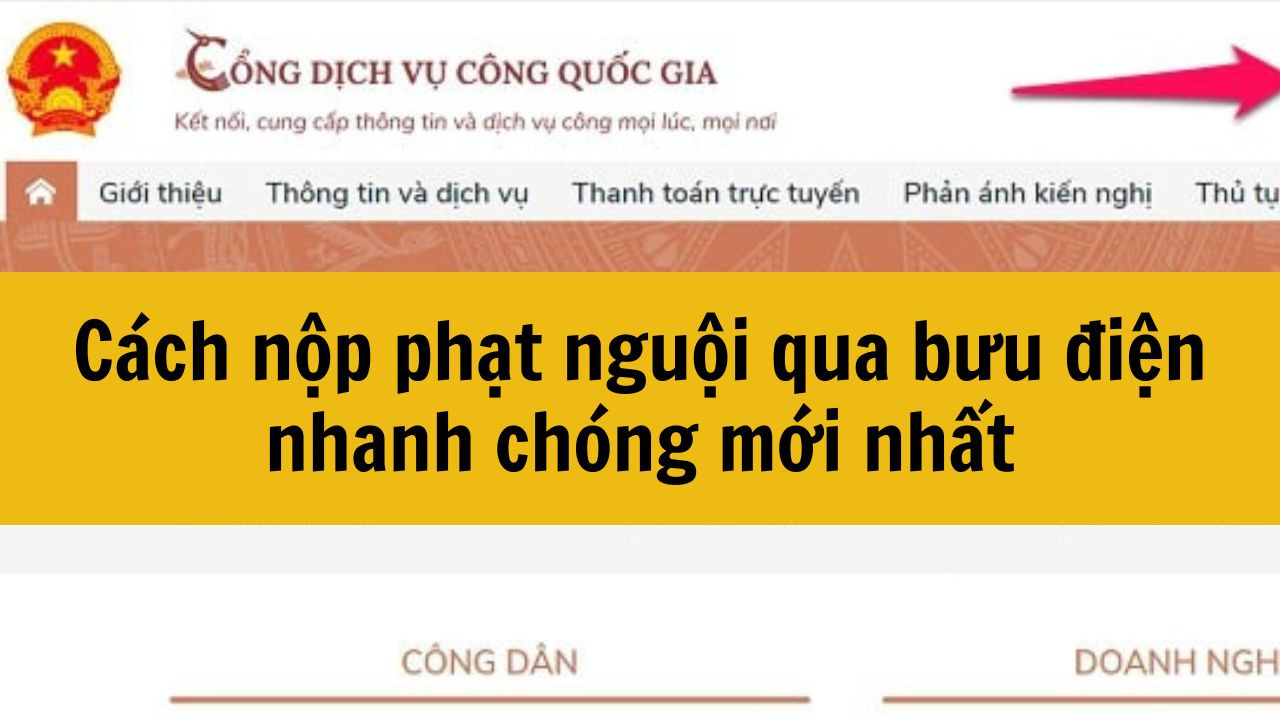
Cách nộp phạt nguội qua bưu điện nhanh chóng mới nhất 2025
Nộp phạt nguội qua bưu điện là giải pháp tiện lợi cho những ai không thể đến trực tiếp cơ quan chức năng. Phương thức này giúp tiết kiệm thời gian, chi phí và đảm bảo đúng quy trình xử lý vi phạm. Dưới đây là hướng dẫn chi tiết cách nộp phạt nguội qua bưu điện nhanh chóng và chính xác nhất năm 2025. 24/02/2025Cách nộp phạt nguội ở tỉnh khác nhanh chóng mới nhất 2025
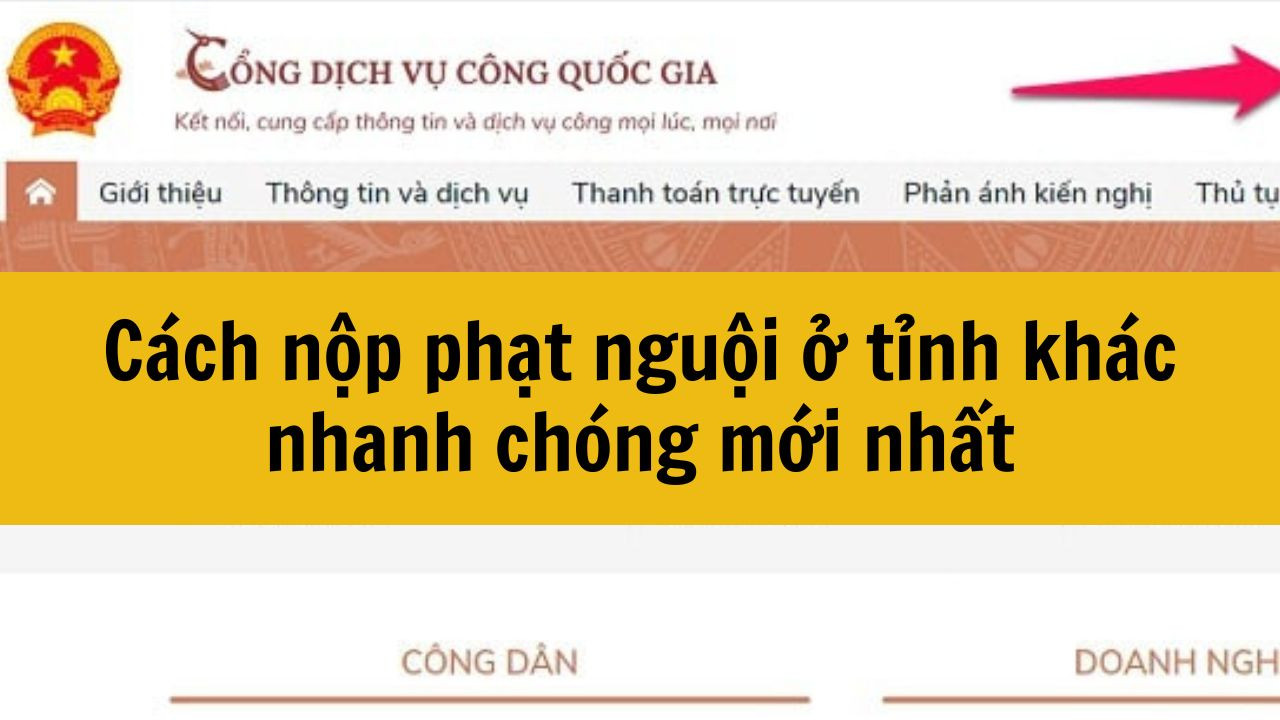
Cách nộp phạt nguội ở tỉnh khác nhanh chóng mới nhất 2025
Bị phạt nguội ở tỉnh khác khiến nhiều người lo lắng về việc nộp phạt sao cho nhanh chóng và đúng quy định. Hiện nay, bạn có thể nộp phạt từ xa mà không cần di chuyển đến nơi vi phạm. Dưới đây là hướng dẫn chi tiết cách nộp phạt nguội ở tỉnh khác nhanh chóng và tiện lợi nhất năm 2025. 24/02/2025Cách nộp phạt nguội qua dịch vụ công nhanh chóng mới nhất 2025
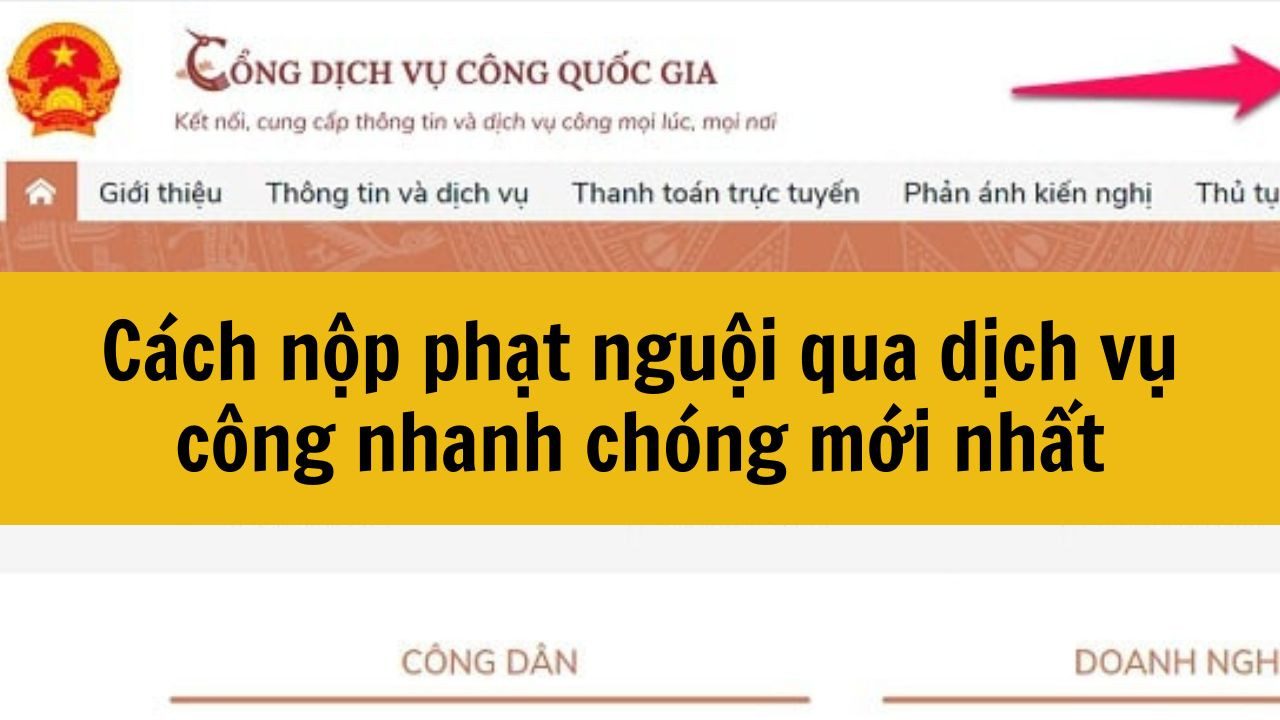
Cách nộp phạt nguội qua dịch vụ công nhanh chóng mới nhất 2025
Nộp phạt nguội qua Cổng Dịch vụ công là cách tiện lợi, giúp người vi phạm hoàn thành nghĩa vụ mà không cần đến trực tiếp cơ quan chức năng. Năm 2025, quy trình này đã được đơn giản hóa, hỗ trợ thanh toán nhanh chóng và dễ dàng. Dưới đây là hướng dẫn chi tiết cách nộp phạt nguội qua dịch vụ công mới nhất. 24/02/2025Hướng dẫn nộp phạt nguội online tại nhà tiện lợi mới nhất 2025
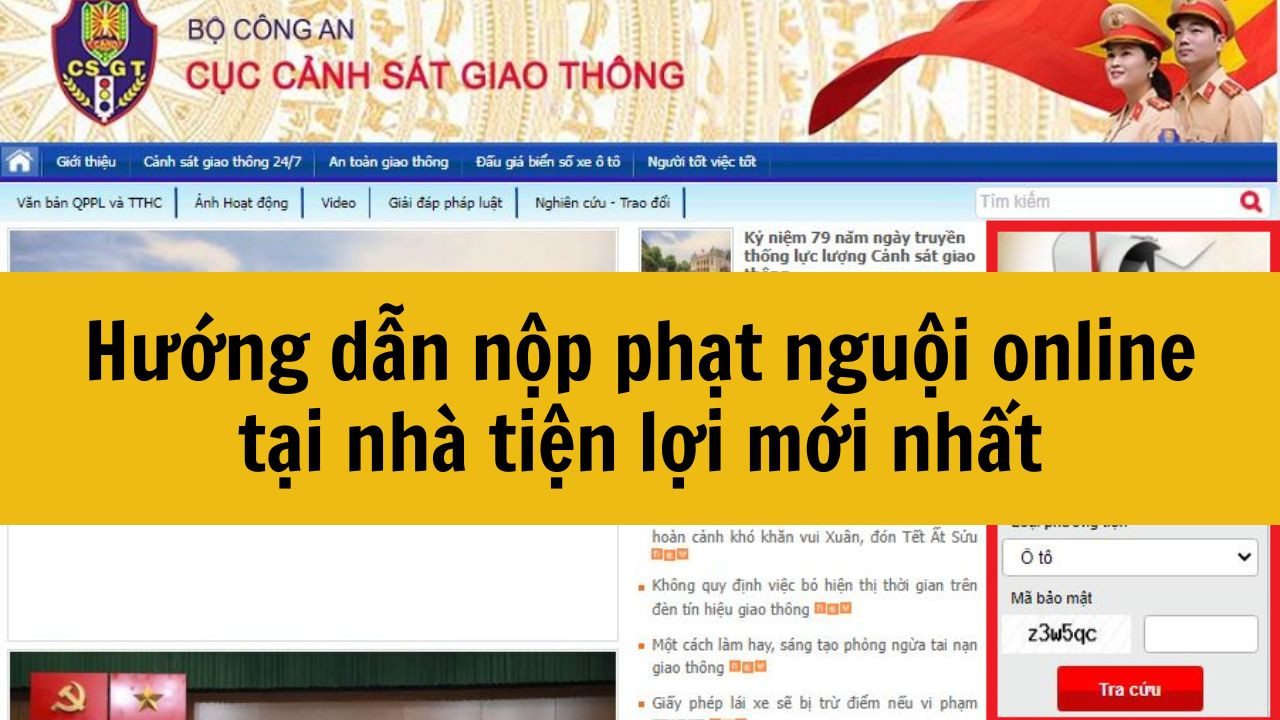
Hướng dẫn nộp phạt nguội online tại nhà tiện lợi mới nhất 2025
Nộp phạt nguội online giúp người vi phạm tiết kiệm thời gian và công sức, không cần đến trực tiếp cơ quan chức năng. Năm 2025, quy trình nộp phạt đã được cải tiến với nhiều phương thức tiện lợi và nhanh chóng. Dưới đây là hướng dẫn chi tiết cách nộp phạt nguội tại nhà đơn giản, chính xác và an toàn. 24/02/2025Nộp phạt giao thông online xong lấy bằng ở đâu?

Nộp phạt giao thông online xong lấy bằng ở đâu?
Sau khi nộp phạt giao thông online, nhiều người thắc mắc lấy lại giấy tờ bị tạm giữ ở đâu. Việc nhận lại bằng lái, đăng ký xe sẽ được thực hiện tại cơ quan có thẩm quyền theo quy định. Bài viết này sẽ hướng dẫn bạn chi tiết địa điểm và thủ tục nhận lại giấy tờ nhanh chóng sau khi hoàn tất nộp phạt online. 17/02/2025Nộp phạt vi phạm giao thông trễ hạn 2 năm có sao không? Cách tính tiền nộp trễ hạn nhanh chóng
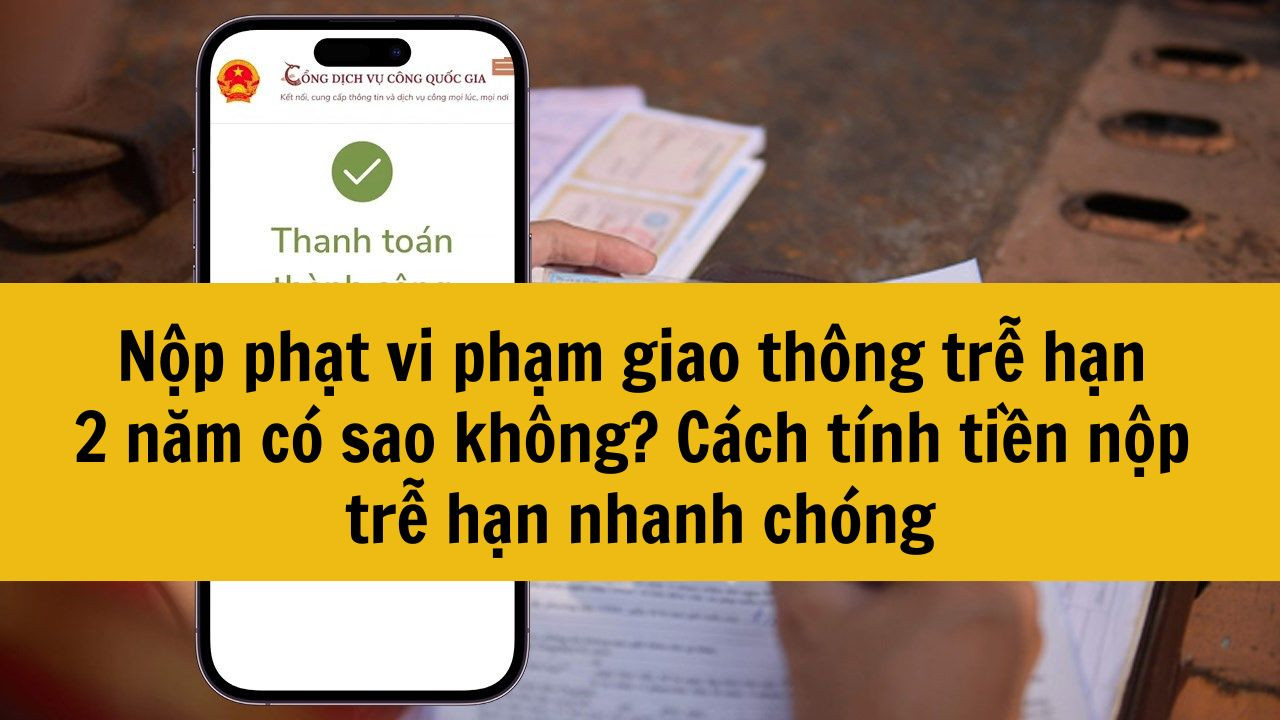
Nộp phạt vi phạm giao thông trễ hạn 2 năm có sao không? Cách tính tiền nộp trễ hạn nhanh chóng
Nếu nộp phạt vi phạm giao thông trễ hạn 2 năm, bạn có thể bị tính thêm lãi suất chậm nộp và gặp rắc rối khi làm thủ tục hành chính liên quan. Vậy mức phạt cụ thể ra sao? Cách tính tiền nộp trễ hạn như thế nào? Bài viết này sẽ giúp bạn hiểu rõ quy định và hướng dẫn cách tính nhanh chóng để tránh phát sinh thêm chi phí. 17/02/2025Nộp phạt vi phạm giao thông trễ hạn 1 năm có sao không? Cách tính tiền nộp trễ hạn nhanh chóng
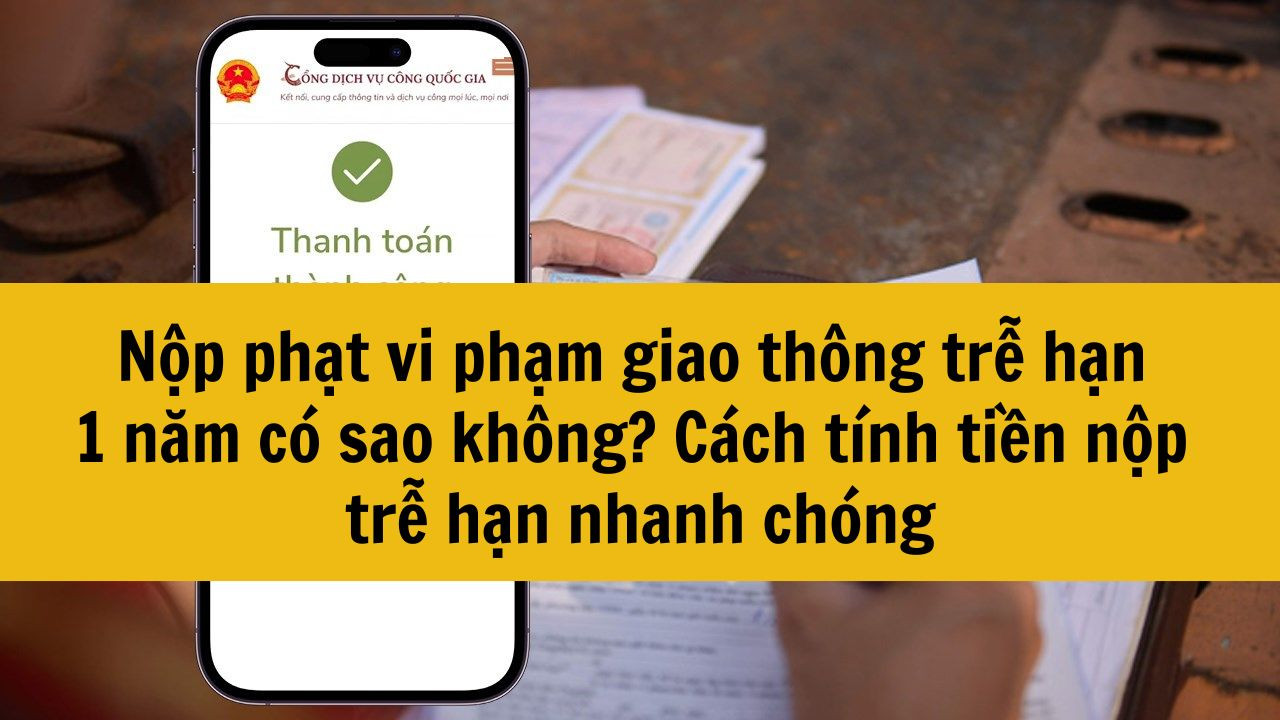
Nộp phạt vi phạm giao thông trễ hạn 1 năm có sao không? Cách tính tiền nộp trễ hạn nhanh chóng
Nếu nộp phạt vi phạm giao thông trễ hạn 1 năm, bạn có thể bị tính thêm lãi suất chậm nộp và gặp rắc rối khi làm thủ tục hành chính liên quan. Vậy mức phạt cụ thể ra sao? Cách tính tiền nộp trễ hạn như thế nào? Bài viết này sẽ giúp bạn hiểu rõ quy định và hướng dẫn cách tính nhanh chóng để tránh phát sinh thêm chi phí. 17/02/2025Thời gian nộp phạt giao thông là bao lâu? Đóng phạt giao thông trễ bị phạt thêm bao nhiêu?
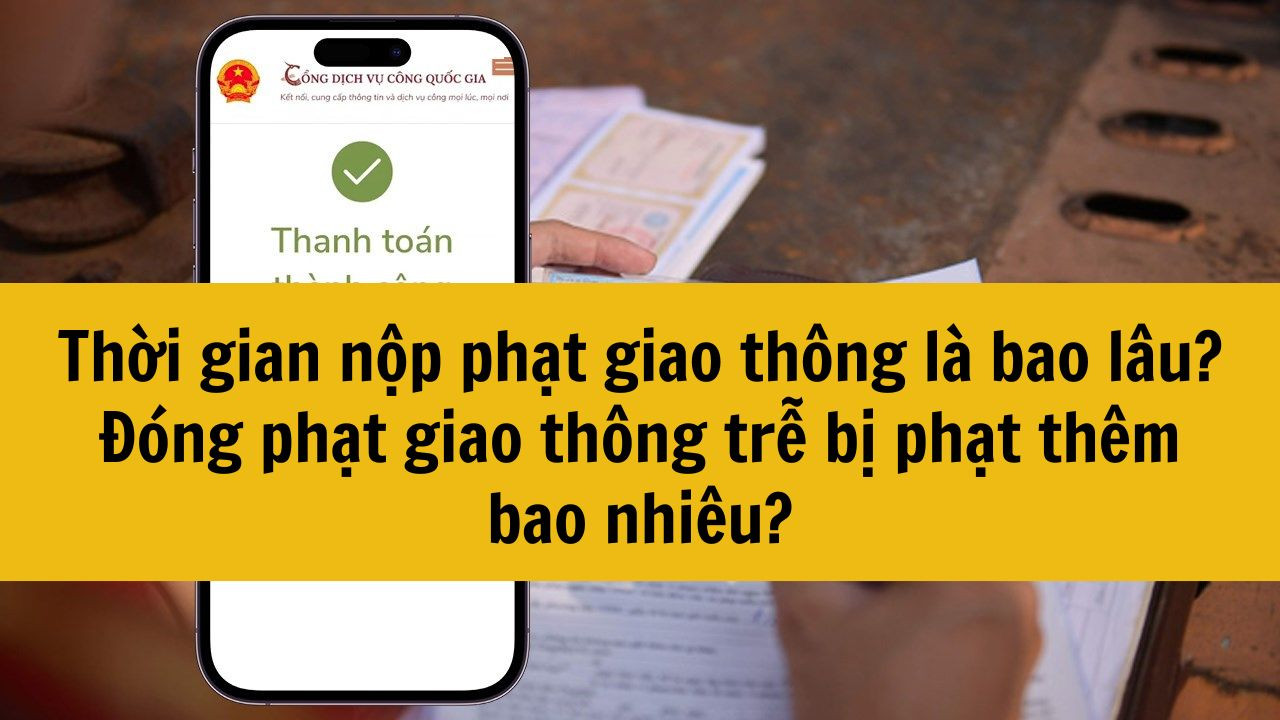
Thời gian nộp phạt giao thông là bao lâu? Đóng phạt giao thông trễ bị phạt thêm bao nhiêu?
Sau khi nhận quyết định xử phạt vi phạm giao thông, người dân có thời gian nhất định để thực hiện nộp phạt. Nếu quá hạn, bạn có thể bị tính thêm lãi suất chậm nộp theo quy định. Vậy thời gian nộp phạt là bao lâu? Mức phạt khi nộp trễ là bao nhiêu? Bài viết này sẽ giúp bạn hiểu rõ để tránh vi phạm và phát sinh chi phí không mong muốn. 17/02/2025Hướng dẫn nộp phạt giao thông qua bưu điện thuận tiện mới nhất 2025
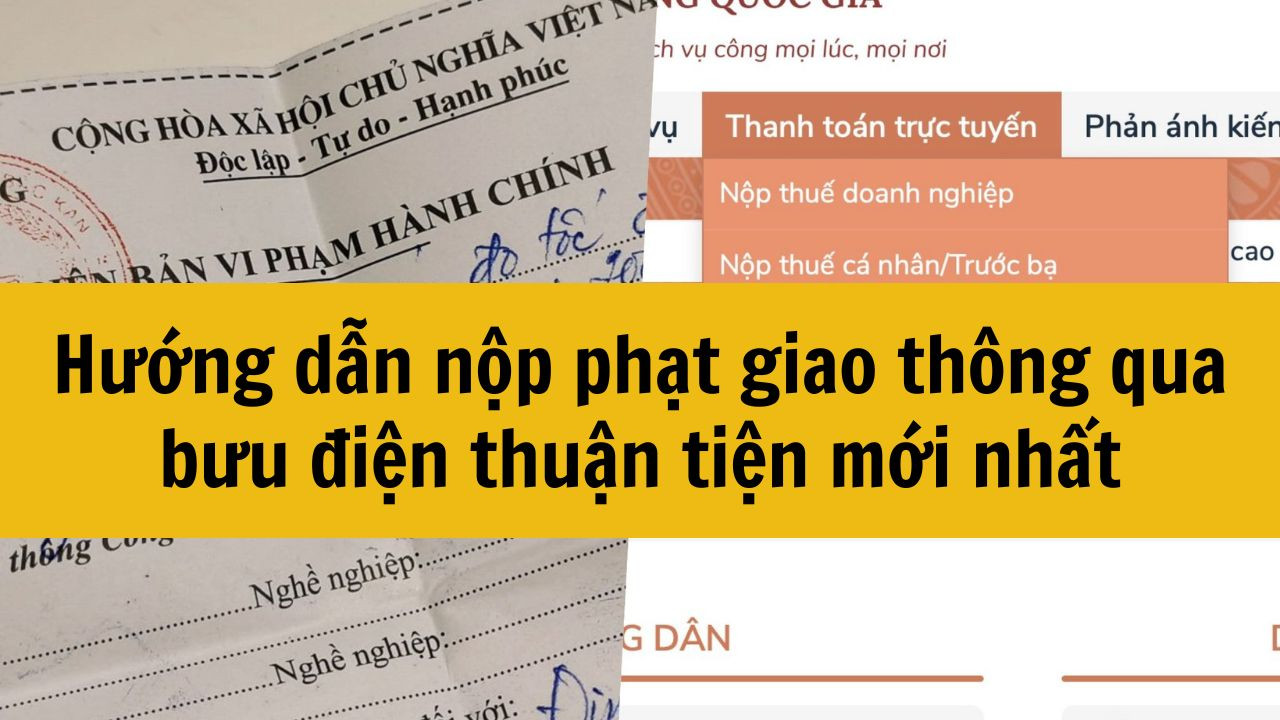
Hướng dẫn nộp phạt giao thông qua bưu điện thuận tiện mới nhất 2025
Nộp phạt vi phạm giao thông qua bưu điện là cách làm tiện lợi, giúp tiết kiệm thời gian mà không cần đến trực tiếp cơ quan xử phạt. Năm 2025, quy trình này tiếp tục được áp dụng trên toàn quốc với nhiều cải tiến. Bài viết dưới đây sẽ hướng dẫn bạn cách nộp phạt qua bưu điện nhanh chóng, an toàn và chính xác. 17/02/2025Hướng dẫn nộp phạt vi phạm giao thông online tại nhà mới nhất 2025
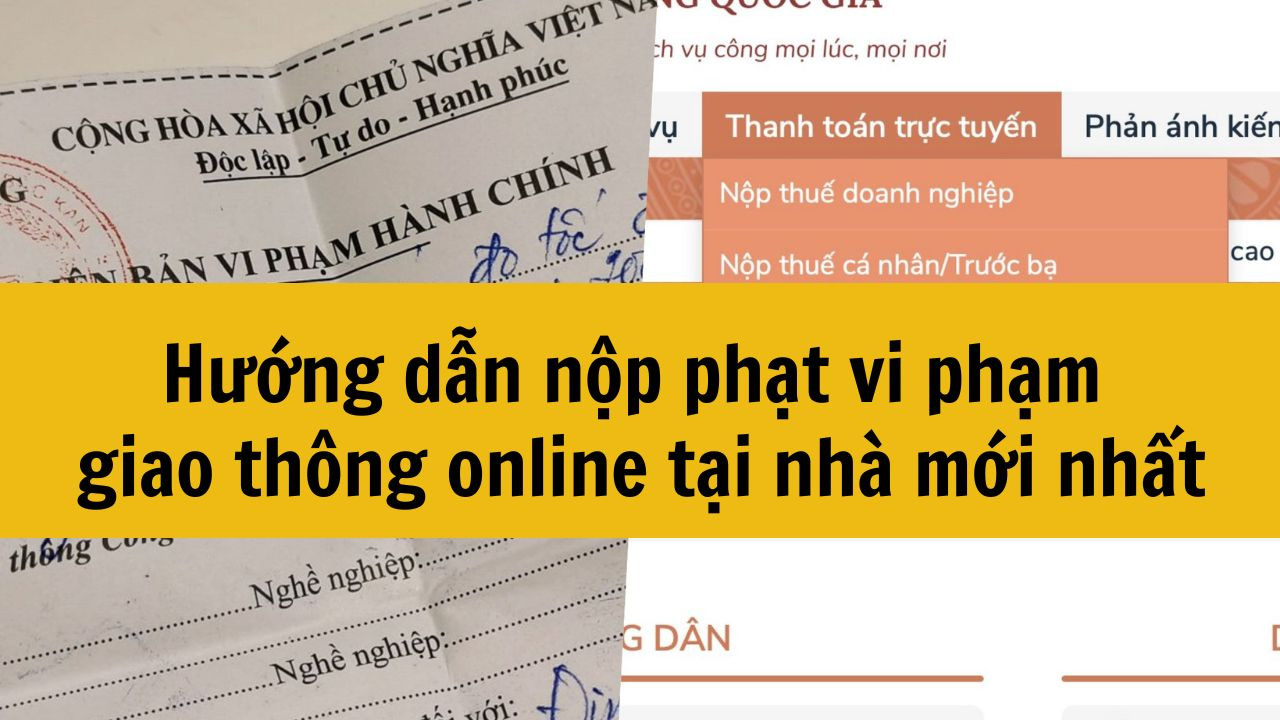

 Thông tư 18/2023/TT-BTC thu nộp tiền phạt bừ trừ số tiền nộp phạt vi phạm hành chính chênh lệch (Bản Word)
Thông tư 18/2023/TT-BTC thu nộp tiền phạt bừ trừ số tiền nộp phạt vi phạm hành chính chênh lệch (Bản Word)
 Thông tư 18/2023/TT-BTC thu nộp tiền phạt bừ trừ số tiền nộp phạt vi phạm hành chính chênh lệch (Bản Pdf)
Thông tư 18/2023/TT-BTC thu nộp tiền phạt bừ trừ số tiền nộp phạt vi phạm hành chính chênh lệch (Bản Pdf)